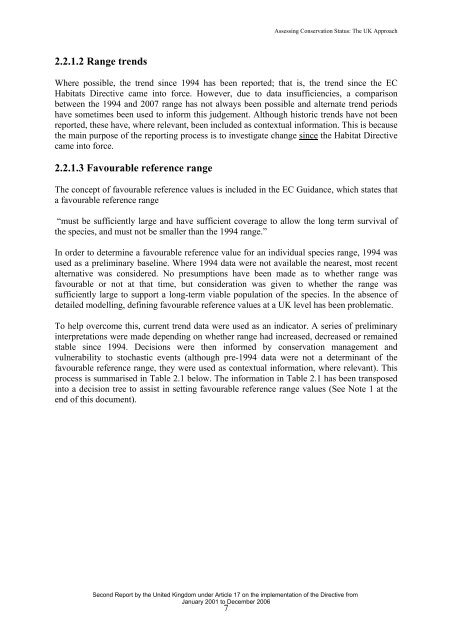Assessing Conservation Status: The UK Approach - JNCC
Assessing Conservation Status: The UK Approach - JNCC
Assessing Conservation Status: The UK Approach - JNCC
Create successful ePaper yourself
Turn your PDF publications into a flip-book with our unique Google optimized e-Paper software.
<strong>Assessing</strong> <strong>Conservation</strong> <strong>Status</strong>: <strong>The</strong> <strong>UK</strong> <strong>Approach</strong><br />
2.2.1.2 Range trends<br />
Where possible, the trend since 1994 has been reported; that is, the trend since the EC<br />
Habitats Directive came into force. However, due to data insufficiencies, a comparison<br />
between the 1994 and 2007 range has not always been possible and alternate trend periods<br />
have sometimes been used to inform this judgement. Although historic trends have not been<br />
reported, these have, where relevant, been included as contextual information. This is because<br />
the main purpose of the reporting process is to investigate change since the Habitat Directive<br />
came into force.<br />
2.2.1.3 Favourable reference range<br />
<strong>The</strong> concept of favourable reference values is included in the EC Guidance, which states that<br />
a favourable reference range<br />
“must be sufficiently large and have sufficient coverage to allow the long term survival of<br />
the species, and must not be smaller than the 1994 range.”<br />
In order to determine a favourable reference value for an individual species range, 1994 was<br />
used as a preliminary baseline. Where 1994 data were not available the nearest, most recent<br />
alternative was considered. No presumptions have been made as to whether range was<br />
favourable or not at that time, but consideration was given to whether the range was<br />
sufficiently large to support a long-term viable population of the species. In the absence of<br />
detailed modelling, defining favourable reference values at a <strong>UK</strong> level has been problematic.<br />
To help overcome this, current trend data were used as an indicator. A series of preliminary<br />
interpretations were made depending on whether range had increased, decreased or remained<br />
stable since 1994. Decisions were then informed by conservation management and<br />
vulnerability to stochastic events (although pre-1994 data were not a determinant of the<br />
favourable reference range, they were used as contextual information, where relevant). This<br />
process is summarised in Table 2.1 below. <strong>The</strong> information in Table 2.1 has been transposed<br />
into a decision tree to assist in setting favourable reference range values (See Note 1 at the<br />
end of this document).<br />
Second Report by the United Kingdom under Article 17 on the implementation of the Directive from<br />
January 2001 to December 2006<br />
7
















